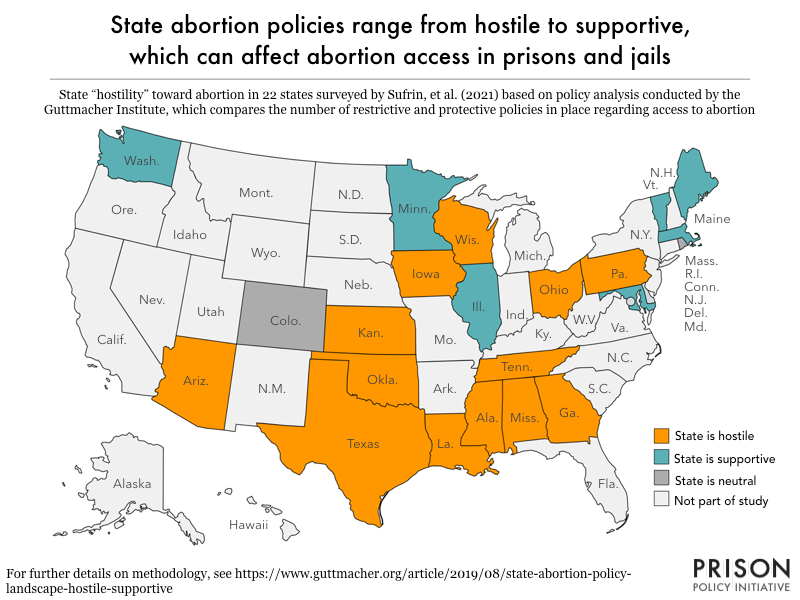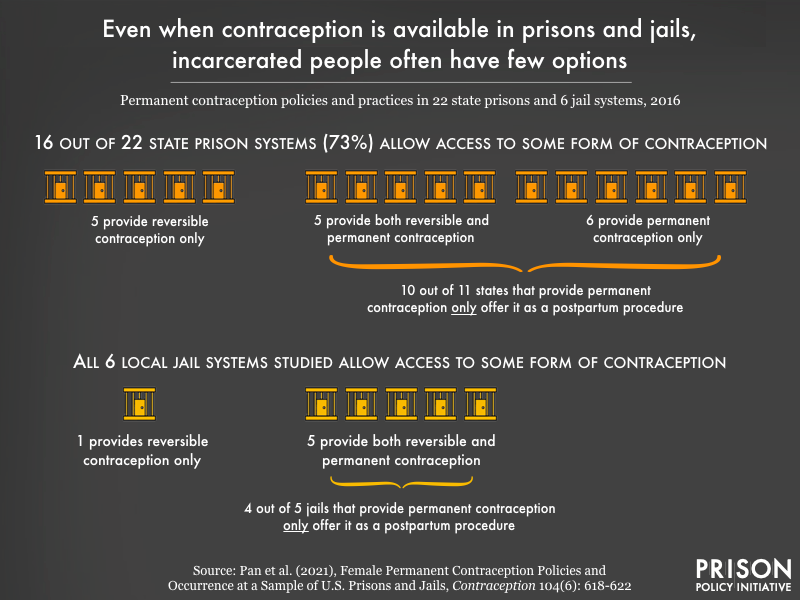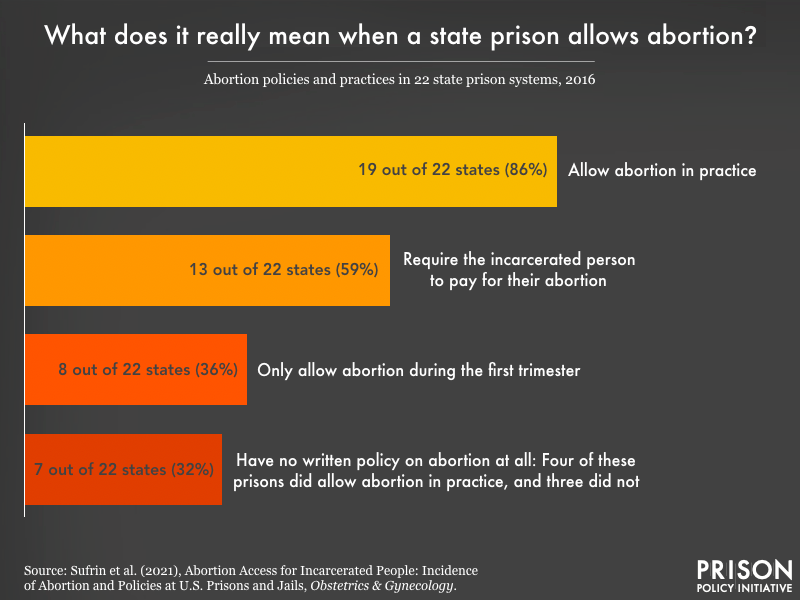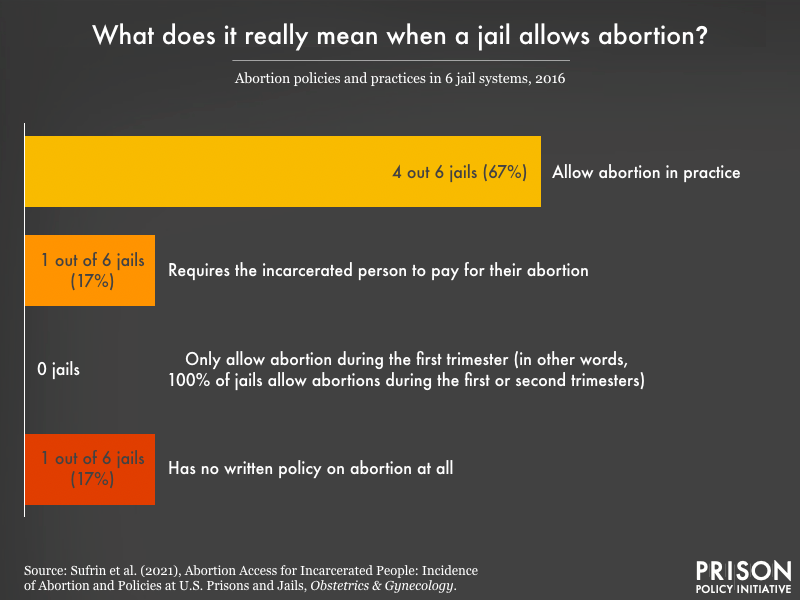Recent studies shed light on what reproductive “choice” looks like in prisons and jails
States that are otherwise hostile to abortion rights are especially likely to make it difficult for incarcerated people.
by Katie Rose Quandt and Leah Wang, December 8, 2021
In the nearly 50 years since Roe v Wade established the right to an abortion without excessive governmental restriction, the courts have repeatedly confirmed that incarcerated people retain this constitutional right. Yet abortion rights throughout the country are under attack: The Supreme Court is currently deciding on a 2018 Mississippi law that bans abortions after 15 weeks, and a new Texas law empowers private citizens to sue anyone who provides an abortion after six weeks — long before many people know they are pregnant. In the first half of 2021, state legislatures enacted 90 abortion restrictions, the most of any year to date.
Life behind bars does not occur in a bubble, and these state policies have implications for the estimated 58,000 pregnant people who enter jail or prison each year. Two articles recently published in medical journals analyzed incarcerated people’s access to abortion and to permanent and reversible contraception across 22 state prison systems1 and six (mostly large) county jail systems.2 3 The studies reveal that abortion and contraception access varies greatly between states — and that abortion access for incarcerated people is related to broader state policies. Even in states that officially allow abortion, many people may be effectively blocked from obtaining the care they need, thanks to insurmountable barriers like self-payment requirements and physical distance from abortion caregivers.4 The studies make clear that people behind bars often have very few — if any — choices and autonomy when it comes to their reproductive health and decisions.
The two articles are based on data from the Pregnancy in Prison Statistics (PIPS) project, a series of studies aiming to fill in significant gaps in data, spearheaded by Dr. Carolyn Sufrin of the Johns Hopkins University School of Medicine and School of Public Health. Earlier studies from this project found a lack of supportive policies for pregnant, incarcerated women, as well as adverse outcomes for expectant mothers and their babies. Taken all together, these studies explain the stakes for incarcerated people during pregnancy — intended or unintended — and the postpartum period: They are likely to receive inadequate prenatal care, give birth without companion support and possibly in shackles, and have their babies taken away immediately after birth.
Main findings
- Most state prison systems (19 of the 22 studied, or 86%) allowed abortion, whether it was written policy or not. Of these, eight allowed it during the first trimester only.
- Seven state prison systems (32%) did not have an official written policy regarding abortion. While four of these states did allow abortions in practice, the lack of policy is concerning and may leave individuals’ access to the discretion of prison staff.
- Three prison systems did not allow abortions at all. None of these three had an official written policy on abortion access, but in practice they did not allow any access, and did not indicate exceptions for rape or incest, in violation of the Constitution.
- Most jails (4 of the 6 studied) allowed abortion. The two that banned abortion were both in Texas: Harris County (Houston) and Dallas County. The four other jails allowed abortion during both the first and second trimesters.
- Abortions are relatively uncommon behind bars: Over the one-year course of the study, there were 33 abortions reported in the study jails and 11 in the study prisons — out of 1,040 total pregnancies that ended in custody during that period.
- Access to contraception varied greatly throughout the study prison systems and jails: Some provided both reversible and permanent contraception,5 but more often than not, women had few choices. Concerningly, some states provided access to permanent contraception (i.e. sterilization), but not reversible contraception.
- More than one-fourth of study prisons offered no contraception access at all.
State hostility to abortion rights affects access behind bars
The authors find that there are correlations between statewide abortion policies and abortion access behind bars. Just three of the study’s 22 state prison systems banned abortion entirely. All three were in states with policies considered “hostile” to abortion rights, a distinction coined by the Guttmacher Institute.6 In all, 77% of state prison systems in hostile states allowed abortion for incarcerated people, compared to 100% of prison systems in nonhostile states. Second trimester abortions were allowed for incarcerated people in 38% of hostile states and 67% of nonhostile states.
The study’s jails revealed a similar pattern: Both of the jails in a hostile state (Texas) banned abortions for incarcerated people, while all four jails in nonhostile states allowed them in both the first and second trimesters.

Abortions can be prohibitively expensive and impossible to obtain, even in states that allow them
The study identified additional barriers to access, even in facilities that officially allow abortion, chief among them payment. Among the study’s 19 state prison systems that allowed abortion, 13 (68%) required individuals to pay for their own abortion care.7 This lack of financial support stems in part from the fact that incarcerated people have been excluded from Medicaid coverage since Medicaid was introduced in 1965.8 And in federal facilities, the Hyde Amendment forbids the use of federal funds on abortions, except to save the life of the pregnant person or in cases of rape or incest.
Although Medicaid funds may not be used on incarcerated people, the paper does reveal a correlation between states that allow Medicaid to cover abortions in the non-incarcerated population, and states that assisted with payment for abortions behind bars. Within states included in the study that have opted to allow Medicaid to cover abortion, 57% of prison systems and 75% of jails paid for an incarcerated people to obtain an abortion over the course of the study (or arranged for an outside source, like Planned Parenthood, to pay). In comparison, in states where Medicaid does not cover abortion in the non-incarcerated population, just 17% of prison systems and 0% of jails paid for (or arranged payment for) an abortion.
Other barriers include a lack of written policies on abortion in some states, and the physical distance to abortion caregivers from many rural prisons. And while pregnancy tests should be given at every intake in every women’s facility, pregnancy testing was not part of official policy in eight (36%) of the study’s prison systems and in one of the study’s six jails (17%). Especially in facilities where abortions are only allowed during the first trimester, this may leave people unaware they are pregnant until it is too late to access abortion.
There are significantly fewer abortions in prison than in the general population
Barriers to abortion access in the greater community are amplified among incarcerated populations. Abortions are already more difficult to obtain for people of color, those living in rural areas, and low-income individuals — many of the same people who are more likely to be incarcerated.
Over the course of the study, 33 abortions were reported in the study jails and just 11 in the prisons — out of 1,040 total pregnancies that ended in custody during that period.
This led to an overall “abortion ratio” of just 1.4% in the study’s prisons (the share of non-miscarriage pregnancies that ended in abortion), which is 13 times lower than the overall U.S. ratio of 18.4% in 2017. In other words, excluding miscarriages, just under one in five pregnancies ended in abortion in the general U.S. population in 2017, compared to one in about 72 pregnancies in prisons. Interestingly, the abortion ratio in study jails was 18%, similar to that of the general population. And looking only at the four jail systems that allowed abortions, that rate was even higher: 33% of non-miscarriage pregnancies that ended in those jails ended with an abortion, suggesting to the authors that “pregnant incarcerated individuals…may actually have an increased need for abortion access.”
The discrepancy between abortion rates in prisons and jails might be partially explained by timing: People typically go to jail before prison, so pregnancies may be more likely to be discovered in jail than prison. Pregnant people entering prisons may also tend to be farther along in their pregnancies, and by then it may be too late to request an abortion, although the study was not able to compare gestational age at admission. In addition, five of the six study jails were in large urban areas in close proximity to abortion caregivers (and four of the six were in nonhostile states) — meaning that access may have been better in the study’s jails than its prisons.
Incarcerated people have few — if any — choices regarding contraception
Prior studies have shown that three-quarters of incarcerated women are of reproductive age and many want to use contraception in advance of their release. The second recently-released PIPS study surveyed prison and jail policies regarding both permanent and reversible contraception (“permanent contraception” here refers to tubal ligation or getting one’s “tubes tied”; reversible contraception methods include methods like IUDs and hormonal implants). As with abortion, many facilities did not have a written policy regarding contraception, meaning actual access in those states might fall to the discretion of staff members.

Among the 22 state prison systems studied, five (23%) allowed both permanent and reversible contraception, five (23%) only allowed reversible contraception, and six (27%) only allowed permanent contraception. The remaining six states (27%) did not offer contraception at all. All six studied jails provided access to reversible contraception, with five also offering permanent contraception.
It is particularly alarming that six prison systems allowed access to permanent contraception, but not reversible contraception. This means that incarcerated people who want contraception may be forced to choose between permanent sterilization or nothing at all. In the context of prisons and jails, permanent contraception is a complex issue that blurs the line between choice and coercion, especially where no other options are provided. An audit of California prisons, for example, found that more than 100 women — particularly women of color — were subjected to illegal sterilization procedures between 2006 to 2010, many of whom did not know their surgeries would prevent them from ever getting pregnant. And in 2020, a whistleblower alleged that an immigration detention center was conducting mass hysterectomies; one detained woman compared it to an “experimental concentration camp.” Historically, forced sterilization has disproportionately devastated the lives of Black, Indigenous and other women of color.
Among the 11 state prison systems and five jails in the study that allowed permanent contraception, this procedure was only available after childbirth as a postpartum procedure in all but one prison system and one jail. This raises two concerns: Outside of prisons and jails, this procedure occurs equally frequently outside the postpartum setting, so only allowing it as a postpartum option limits choice. Secondly, incarcerated people are often in a particularly vulnerable position after giving birth in prison: They generally have no choice in their healthcare provider or birth location, and have little privacy. This vulnerability could further contribute to coerced decisions regarding postpartum permanent contraception.
In fact, as the study notes, the American College of Obstetricians and Gynecologists advises that incarcerated women should rarely undergo permanent sterilization — and only then if long-acting reversible contraception is also available, and if there is documentation of a pre-incarceration request for the procedure.
Prisons and jails must expand access to reproductive healthcare, both in policy and practice
Pregnancy overlaps with incarceration often enough that prisons and jails should have clear policies and procedures to screen for pregnancy, provide quality prenatal and postnatal care, and ensure that incarcerated people have access to safe abortions, deliveries, and contraception, as they are entitled to by law. People do not lose their constitutional right to reproductive autonomy when they are incarcerated. Yet these two recent studies reveal abortion and contraception policies that are sometimes unwritten, sometimes unconstitutional, and frequently undermine individuals’ autonomy. They also make evident that more ongoing data collection is needed. Significant data remains uncollected,9 including demographic data (broken down by race, ethnicity, gender identity, etc.), which would allow us to see any disparities in pregnancy outcomes and access to contraception.
In many states where abortion is currently allowed behind bars, the narrow existing window of abortion eligibility may be shut if Roe v Wade is overturned by the Supreme Court. The Guttmacher Institute expects that 26 states are certain or likely to ban abortion if the right is not protected by the Constitution.10 In Texas, for example, the new law bans abortions after six weeks. The jails in Harris County (Houston) and Dallas County do not allow abortions at all, meaning that an incarcerated person in early pregnancy could easily miss this tiny window of eligibility while jailed, and not be able to obtain an abortion upon release. And while people on the outside can — if they have the means — travel to a nonhostile state for abortion care, those in jails and prisons are held captive to the policies of their states.
The study’s findings suggest clear policy recommendations:
- Prioritize the diversion and/or early release of pregnant people from jail and prison, in recognition of the existing, serious risks to parental and infant health and well-being in carceral settings.
- Standardize correctional health care and require oversight to ensure all incarcerated people are provided standard reproductive health services.
- Establish clear, written policies regarding access to abortion care and contraception.
- At intake, screen for pregnancy and provide clear information about how to access available services.
- Provide non-coercive access to begin or end reversible contraception.
- Ensure that abortion access in all facilities is in line with state and federal law.
- Remove financial barriers to needed services for incarcerated people: State and local authorities should cover the cost of abortions and contraception for incarcerated people, or arrange for costs to be covered by service provider partners.
- Connect pregnant people with needed services upon release from jail or prison.
- Collect more data, disaggregated by race, ethnicity, gender identity, and other individual characteristics, on pregnancy prevalence, outcomes, policies, practices, and individual experiences — including requests for both reversible and permanent contraception.
Footnotes
-
The articles do not identify which states do or do not allow access to abortion and contraception, but do note that the study prison systems included Alabama, Arizona, Colorado, Georgia, Illinois, Iowa, Kansas, Louisiana, Maine, Maryland, Massachusetts, Minnesota, Mississippi, Ohio, Oklahoma, Pennsylvania, Rhode Island, Tennessee, Texas, Vermont, Washington, and Wisconsin. (Wisconsin’s data represent just one of the three state prisons that house women.) These 22 prison systems hold 58% of women in US prisons. ↩
-
The jail systems included Cook County (Illinois), Dallas County (Texas), Hampden County (Massachusetts), Harris County (Texas), Los Angeles County (California), and New York City (New York). These counties include the five largest jail systems in the country, and hold 5% of all women in US jails. ↩
-
The article on abortion access also analyzed monthly data on pregnancy outcomes in these facilities and all 26 federal Bureau of Prisons (BOP) facilities housing females over the course of 12 months in 2016 and 2017. The BOP did not participate in the study’s policy survey, however. ↩
-
These new papers, while concerning, are not necessarily surprising, considering what we already know. Our 2019 50-state survey found that prisons often lack official policies and humane practices for the treatment of pregnant women. And in New York State (which was not a part of these studies’ prison cohort) had no written policy related to abortion, pregnancy options counseling, or hysterectomies as of 2015. ↩
-
The study looked at access to permanent contraceptive methods (i.e. tubal ligation), as well as reversible contraception (which includes short-acting methods like birth control pills, as well as long-acting methods like IUDs and subdermal implants). ↩
-
As of the end of 2020, six states throughout the country were considered very hostile to abortion rights, 15 were hostile, and eight leaned hostile. ↩
-
For example, Arizona’s policy states: “Elective abortions are only performed if the inmate is able to pay for all costs related to the procedure. Related costs include all doctor and allied health clinician fees; all laboratory and diagnostic tests completed; all inpatient hospital costs, including surgery; all medication costs; all transportation costs to and from medical appointments related to the abortion procedure; all security costs including staff/labor costs; all follow-up medical/mental health costs following the completion of the procedure.” This amounts to a significant expense: One provider’s website shows a cost range (depending on gestational age) from $640 to $2,500. A medical abortion costs $620 out of pocket. This policy virtually guarantees incarcerated people won’t be able to get an abortion if they want one, for financial reasons alone. ↩
-
The Affordable Care Act allowed states to opt in to the “Medicaid expansion,” which provides additional federal funds to expand Medicaid coverage. In some cases, states that have opted in to the expansion may be able to receive Medicaid reimbursements for some care delivered outside of correctional institutions for Medicaid-eligible incarcerated people. ↩
-
Federal-level pregnancy data has only been regularly collected since the 2018 First Step Act. The Survey of Prison Inmates, which includes state prisons, is not collected often, and does not track pregnancy outcomes, just pregnancy prevalence. ↩
-
The following 21 states have preexisting laws banning (or nearly entirely banning) abortion that would go into effect without Roe: Alabama, Arizona, Arkansas, Georgia, Idaho, Iowa, Kentucky, Louisiana, Michigan, Mississippi, Missouri, North Dakota, Ohio, Oklahoma, South Carolina, South Dakota, Tennessee, Texas, Utah, West Virginia, Wisconsin. The following five states seem likely to ban abortion as soon as possible without federal protections in place: Florida, Indiana, Montana, Nebraska, and Wyoming. ↩





